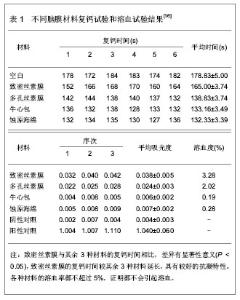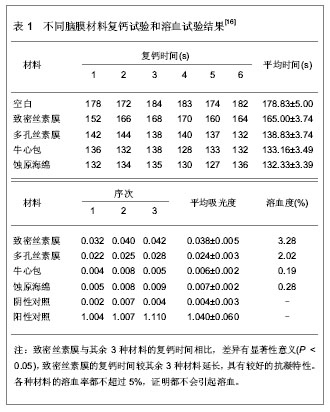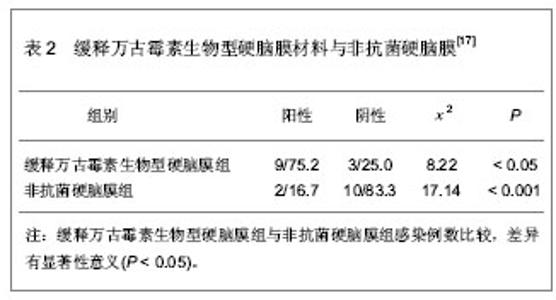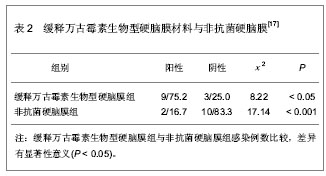Chinese Journal of Tissue Engineering Research ›› 2013, Vol. 17 ›› Issue (29): 5415-5420.doi: 10.3969/j.issn.2095-4344.2013.29.023
Artificial dura materials in neurosurgical procedures: An analysis of 100 cases
Wei Peng-xiang, Li Dan-qing, Zhou Yu-jia, Liu Jia-lin, Wang Lei
- Department of Neurosurgery, Dongfang Hospital of Beijing University of Chinese Medicine, Beijing 100078, China
-
Received:2013-03-21Revised:2013-06-27Online:2013-07-22Published:2013-07-22 -
Contact:Li Dan-qing, Master, Department of Neurosurgery, Dongfang Hospital of Beijing University of Chinese Medicine, Beijing 100078, China -
About author:Wei Peng-xiang☆, M.D., Professor, Doctoral supervisor, Department of Neurosurgery, Dongfang Hospital of Beijing Ministry of Education, Beijing 100078, China
CLC Number:
Cite this article
Wei Peng-xiang, Li Dan-qing, Zhou Yu-jia, Liu Jia-lin, Wang Lei. Artificial dura materials in neurosurgical procedures: An analysis of 100 cases[J]. Chinese Journal of Tissue Engineering Research, 2013, 17(29): 5415-5420.
share this article

2.1 自体硬脑膜修复材料 患者自身的筋膜、骨膜、帽状腱膜以及阔筋膜等组织可以用作硬脑膜修复材料的来源。患者自身组织不会发生免疫排斥反应,有学者曾经从细胞组织学水平的角度认为筋膜能够诱导原始巨噬细胞积聚并发生吞噬作用,通过实验证明移植的筋膜组织在1年以后基本被吸收,被新生组织代替。所以,目前在世界范围内广泛认为自体来源的材料是最安全的,而且是引起并发症最少的脑膜替代材料[4]。 牟永告等[5]应用自体组织修补脑肿瘤治疗中硬脑膜缺损,选取神经外科实施开颅脑肿瘤切除治疗中硬膜修补的患者122例,自体组织取材方法为帽状腱膜下层、骨膜、硬脑膜外层切开分离反折以及大腿阔筋膜。硬脑膜修补根据缺损大小选择适当的自体材料,修补效果满意,治疗后未出现感染、脑脊液漏、硬脑膜下积液等并发症,随访6个月以上,无不良反应。自体帽状腱膜下组织取材方便,伸缩性强,可根据缺损范围大小灵活掌握,最实用。骨膜取材也方便,伸缩性不如帽状腱膜下组织。硬脑膜外层反折适用于复发肿瘤再次治疗时,特别是放疗后患者,硬脑膜增厚,外层容易剥离,缝合容易,但注意组织较脆,缝合时力度应适中。大腿阔筋膜与硬脑膜结构相似,比较理想。 但自体硬脑膜修复材料还存在一定的不足,组织的提取需要另外附加的手术完成,有些伴有骨组织病变的患者,如肿瘤患者颅骨本身就被肿瘤细胞侵蚀,不能提供骨膜组织,或者是脑膜缺损较大没有足够的自身组织修补缺损[6]。 2.2 同种异体硬脑膜修复材料 人体干冻硬脑膜材料:应用时间达30余年的同种异体硬脑膜修复材料Lyodura来源于人尸体,经过冷冻干燥加工后制成的商品,经过加工的异体硬脑膜材料与人体新鲜的硬脑膜具有相同特征,而且制备简单、植入方便,可以长期保存,并保留新鲜脑膜的生理特性[7]。 但同种异体硬脑膜材料的来源有限[8],缺乏捐献者,还有伦理学方面的问题。而且价格昂贵,限制其应用。同时,蛋白病毒的存在是限制异体硬脑膜材料应用的主要原因,是一种罕见的、致命性可传染的疾病,此外,人体干冻硬脑膜材料也可能引起肝炎、免疫缺陷病毒或细菌感染等发生[9]。 无细胞人体真皮:无细胞人体真皮是在真皮组织上除去表层和真皮的细胞成分,保存组织的分子和结构特征,在制作过程中,除去人体主要组织相容性抗原。在免疫学上是惰性的。经过冷冻、干燥保存于冰箱提供2年使用期,这样既消除应用其它同种异体材料时可见的免疫排斥反应,又因为分子超微结构的存在成为一个模板,诱导组织内皮细胞和血管内皮细胞再生形成新的脑膜,并且有较长的保存期。无细胞人体真皮材料的优点:①易于缝合,脑脊液不会从针孔中漏出,材料柔软、有弹性、为脑保护提供屏障。②易于制备和储存,使用前需10 min的再水化即可以使用。③不传递感染,特别是人类免疫缺陷病毒的传递和长潜伏期的阮病毒介导的疾病,因为无细胞真皮的加工过程使得这种材料完全没有细胞,即病毒无寄存的宿主,另外,病毒仅存在于中枢神经组织,因此真皮不是贮存的部位,不可能传递阮病毒。无细胞人体真皮已经在牙周病和整形重建外科中使用超过200万例,到目前为止尚无传递疾病的报道,无细胞人体真皮的加工过程显著减少了粘连形成和免疫排斥反应。由于无细胞真皮是人体皮肤组织的衍生物,其缺陷是材料制品有孔,在植入前应该仔细检查,避免脑脊液漏的发生。 2.3 异种硬脑膜修复材料 异种硬脑膜修复材料应用较多的是牛心包膜、羊心包膜、猪腹膜等。异种硬脑膜修补材料的优点是资源丰富,易于制备,感染传递的发生率低,对脑组织无毒性作用,具有良好的完整性,表面光滑,与脑组织不发生粘连。 牛心包膜:牛心包膜作为硬脑膜修复材料在应用前需要经过戍二醛处理,这样可以减少牛心包膜的钙化,因为牛心包膜上的空隙较多,将纤维母细胞移至心包膜内,可以减少钙化,同时,苯妥英纳的抗维生素D作用,也可以使钙化降低。牛心包膜与下方皮质间很少或没有粘连形成,在实际应用中,脑膜缺损尺寸不会很大,牛心包膜的厚度在(0.40±0.02) mm,张力强度在685 g/mm2,弹性30%,这与人体的硬脑膜基本相似。另外,在柔软度、易于裁剪以及缝合方面,与尸体干冻脑膜相比,两种脑膜的感染率都很低,且都无免疫排斥反应,只是前者的可使用性、厚薄和柔软性更好,经过戍二醛处理使牛心包膜内部的天然胶原交叉结合,提高材料的结合性能同时增强其力度和牢固性。 猪腹膜:猪腹膜也是一种较好的人工硬脑膜缺损修材料,腹膜为身体内面积最大、分布最复杂的浆膜,由皮以及少量结缔组织构成,薄而光滑,呈半透明状。位于腹腔和盆腔壁内表面的腹膜为壁腹膜,位于覆盖腹腔和盆腔脏器表面为脏腹膜。猪脏腹膜表面因十分光滑,很少和受体脑组织发生粘连[10]。猪腹膜的生物与物理性能好,厚度近似于人硬脑膜,而且更具有韧性,抗拉力也强于硬脑膜,且能对合严密,愈合较快。取材方便且较完整,适用于修补面积较大的硬脑膜或硬脊膜缺损。 2.4 合成脑膜修复材料 膨聚四氟乙烯材料:膨聚四氟乙烯是一种常用的人工合成材料,作为人工硬脑膜材料与脑组织表面的反应较小,与脑表面间没有粘连,无异物巨细胞,生物相容性良好。但膨聚四氟乙烯有一点不足之处在于脑脊液可以从缝合的针孔中漏出,引起脑脊液漏,有实验通过缩小针孔大小来防止脑脊液漏[11],也有应用纤维蛋白原液浸泡的可吸收聚乙醇网覆盖在缝合处,然后将凝血酶液缓慢的渗透到网下,形成一个加强的纤维网膜,可以有效的防止脑脊液漏[12]。 涤纶材料:涤纶材料质地柔软,并有一定弹性,可以按需修剪成任意形状和大小,而且韧性较强,抗缝线托曳性强,与硬膜缝合后不易撕裂。在组织相容性方面,涤纶材料一般不会发生免疫排斥反应,其纵横有序的纤维织面,使胶原纤维及成纤维细胞可以附着其上,在内侧面形成一层光滑的纤维素层,防止脑组织直接与皮瓣内侧接触粘连,降低脑室贯通畸形以及癫痫的发生。外侧面与新生结缔组织粘连后,结合较紧密,减少皮下积液的发生,使创面达到生物学愈合。 涤纶补片材料的生物相容性较好,王伟民等[13]将涤纶作为人工硬脑膜修复材料,对73例患者行硬脑膜修补,外伤减张缝合47例,外伤致硬膜缺损9例,脑膜瘤侵蚀硬膜11例,Arnold-Chiari畸形减张缝合6例。根据所剪硬膜片数将涤纶补片修剪成相应形状,与原硬膜边缘缝合。行硬膜弧形剪开时应将涤纶补片修剪成半月形或马蹄形,开放性外伤致硬膜缺损时应先行清创,消毒满意后修剪破碎硬膜边缘再行修补,创口暴露时间较长污染较重的不宜一期修补,脑膜瘤发生处的硬膜应相应扩大去除范围。73例硬脑膜修补患者中,2例外伤患者死于治疗后并发症,其余患者均未出现急慢性免疫排斥反应以及感染,可见,涤纶补片的相容性较好,治疗中探查发现涤纶材料外侧面已与皮瓣内侧结缔组织良好粘连,所有孔隙均由胶原纤维束填充,内侧面已形成一层光滑的纤维素附着面,未与脑组织形成粘连。 2.5 天然脑膜修复材料 天然脑膜修复材料包括胶原膜、蚀原海绵等,天然脑膜修复材料不会产生严重的慢性炎症反应,降解速度不容易控制,容易使材料破碎,引起并发症。 蚀原海绵:蚀原海绵是一种较常用的移植材料,来源于牛的跟键,最初作为牵开器下方脑表面的一种保护材料。容易成形,使用方便,不需要缝合。由于蚀原海绵是多孔的,不能够防止脑脊液漏。Natotam等[14]报道蚀原海绵作为脑表面修补材料在植入5年内的变化情况,在蚀原海绵或自体脑膜中没有中性白细胞、淋巴细胞、巨细胞,在脑组织中也没有星形细胞增生,表明蚀原海绵在免疫学方面易被人体接受。另外,也未见出血、囊膜包裹或假性肿瘤形成。在没有明显脑水肿的情况下,没有引起脑脊液漏的危险,蚀原海绵的海绵样特性使其能吸收液体而不增大体积,作为一种湿润物质覆盖于脑组织之上,脑脊液能渗透入修补材料,可以使蚀原海绵在脑组织和被覆盖组织之间形成有效的分隔层,减少粘连的形成。蚀原海绵的孔以及海绵样的特性,使得早期来源于手术区血液中的纤维蛋白很容易直接穿透进蚀原海绵,蚀原海绵作为支架,为其迅速生长提供了条件。 壳聚糖和羟丁基壳聚糖:陈汇浩[15]对壳聚糖硬膜补片和羟丁基壳聚糖修复硬脑膜进行实验研究,将36只新西兰兔随机平均分为壳聚糖硬膜组、牛心包组、羟丁基壳聚糖组和空白对照组,按分组分别将复合壳聚糖补片、牛心包、羟丁基壳聚糖生物硬膜补片覆盖于硬脑膜缺损处构建硬脑膜缺损修复动物模型。治疗后复合壳聚糖硬膜补片以及羟丁基壳聚糖均未引起机体的免疫排斥反应,实验组硬膜缺损处有新的胶原纤维层形成,局部无粘连,无明显炎性细胞浸润,随着时间推移胶原纤维层逐渐成熟。牛心包组局部无明显粘连,无炎性细胞浸润,材料逐渐降解,毛细血管长入,但未形成新的胶原纤维层。空白对照组脑组织粘连严重,并呈过度纤维化。Masson’s表明在除空白以外各组胶原纤维随时间推移不断增加,排列由疏松变得致密,牛心包组的胶原纤维组织要多于壳聚糖硬膜组和羟丁基壳聚糖硬膜组。壳聚糖硬膜组、羟丁基壳聚糖组以及牛心包组CD34阳性表达逐渐增高,空白对照组与壳聚糖硬膜组和羟丁基壳聚糖组间差异有显著性意义(P < 0.01)。说明复合壳聚糖硬膜补片以及羟丁基壳聚糖均可以抑制成纤维细胞增生和瘢痕形成。 丝素膜:丝素膜是以桑蚕丝为原料,经脱胶、溶解、透析提纯,制得纯净的丝素溶液,再将丝素溶液置于塑料模具中,经烘干制成薄膜。但是,这种丝素膜在水中会溶解,还需要用化学或物理的方法进行处理,使丝素分子间产生交联,使这些膜不溶于水。化学交联通常是用具有双反应官能团的交联剂来完成的,比如戊二醛。物理交联的方法之一是促成晶体的形成。将天然的或再生的丝素膜浸泡在甲醇水溶液或用70%-90%浓度酒精进行短时间的浸渍处理,都可促使膜的结构发生变化。丝素膜体外细胞培养基质,蛋白质具有特殊的超微物理构造和多孔结构,丝素膜能良好的适应机体组织,而且容易取得高纯度,且细胞附着状态好,细胞在丝素膜上有生存和繁殖的营养,细胞有增殖能力。所以,丝素作为一种生物相容性材料是众所周知的。丝素降解的产物对人体无毒性,因为丝素蛋白质是由氨基酸组成的。各种类型的丝素材料已被制成凝胶、薄膜和微孔材料等。 有学者观察丝素膜、牛心包等作为硬脑膜修复材料的生物相容性,通过复钙时间、溶血试验、血小板黏附试验来测定材料的血管相容性,通过对实验兔硬脑膜缺损的修复观察材料的组织相容性[16]。4种材料的复钙试验结果及溶血试验结果,见表1。"


此外,各种材料修补的实验兔没有发现伤口感染、脑膜炎及抽搐现象,行为及进食无异常变化。多孔丝素膜、环氧丝素膜、SD-1丝素膜和牛心包4种材料植入后早期,炎症反应均轻微。晚期,多孔丝素膜、环氧丝素膜、SD-1丝素膜3种实验材料显示轻度的慢性炎性反应,对照材料牛心包组慢性炎性反应程度较轻。丝素膜与脑皮层之间可见薄层假膜形成。脑皮质形态均正常。可见,丝素膜具有良好的生物相容性。 新型人工硬脑膜材料:陈世洲[17]研究缓释万古霉素生物型硬脑膜材料的物理性能和体外药物缓释以及抑菌情况,体内安全性以及预防感染的作用。缓释万古霉素生物型硬脑膜材料的水压力实验可见应力范围内压力-体积曲线有3段组成,在2.7-9.7 N/cm2的范围内压力-体积基本呈线性关系,表明缓释万古霉素的生物型硬脑膜材料具有良好弹性和压力顺应性,是良好的弹性材料。 体外药物缓释实验数据统计分析结果显示每平方厘米的缓释万古霉素生物型硬脑膜新型材料在体外药物缓释的时间-浓度呈线性关系,在5 d内随时间延长药物浓度持续升高,5 d以后浓度随着时间基本呈水平趋势。体外抑菌实验结果显示直径为6 mm的缓释万古霉素生物型硬脑膜新型材料体外抑菌圈直径5 d内随时间延长逐渐缩小,5 d后未见有抑菌圈,而标准膜片只在第1天内可见抑菌圈。缓释万古霉素生物型硬脑膜材料在动物实验感染分析中的研究结果,见表2。"


史志东等[18]对临床患者及犬进行开颅治疗,比较生物型人工硬脑膜和自体骨膜修补硬脑膜的预后。选择临床治疗患者30例,24例行生物型人工硬脑膜修补硬脑膜,6例行自体膜修补;选择的实验犬分为1,6,12,24个月以及更长时间5组,每组3只,每只犬分别应用生物型人工硬脑膜以及自体膜修补硬脑膜,修补后观察不同修补材料的预后。结果所有临床患者治疗后观察均无颅内感染、脑脊液漏及癫痫发生。应用生物型人工硬脑膜修补材料的动物解剖显示,修补材料外表面与颅骨膜有少许粘连、易分离,与周边缝合的硬脑膜已完全愈合,不可分辨,不能分离。从生物型人工硬脑膜以及自体膜两种修补材料内表面来看,前者生长更接近硬脑膜,与脑表面无粘连或偶有丝状粘连,而自体膜与脑表面有丝状粘连并有少许柱状粘连。组织学镜下显示,两种修补材料与硬脑膜之间无嗜中性粒细胞、淋巴细胞等炎症细胞反应,无囊壁形成。生物型人工硬脑膜内表面可见上皮细胞覆盖,上皮下可见纤维组织增生,纤维母细胞增生,该修补材料被降解,总量明显减少,内部可见毛细血管。可见,用生物型人工硬脑膜作硬脑膜修补后,该型修补材料的特性使其能产生上皮,不易形成与脑组织的粘连,并逐渐被自体组织蚕食、降解和替代,达到具有实际意义的硬脑膜重建。生物型人工硬脑膜在修补硬脑膜缺损的实际应用中比自体膜有更大优越性。北京中医药大学东方医院神经外科100例手术患者,其中脑肿瘤30例,脑血管病50例,脑外伤20例,选用胶原蛋白人工硬脑膜减张修补硬膜。术后发生硬膜外积液3例,经适当脱水治疗后治愈;其余无不良反应发生。"

| [1] Yamada K, Miyamoto S, Takayama M, et al. Clinical application of a new bioabsorbable artificial dura mater.J Neurosurg.2002;96(4):731-735.[2] Medline.Pubmed[DB/OL].2012-08-10.http://www.ncbi.nlm.nih. gov/pubmed/[3] 中国知网.中国学术期刊总库[DB/OL].2013-4-12. https://www.cnki.net[4] Warren WL, Medary MB, Dureza CD, et al. Dural repair using acellular human dermis: experience with 200 cases: technique assessment.Neurosurgery.2000;46(6):1391-1396.[5] 牟永告,赛克,张湘衡,等.自体组织修补脑肿瘤术中硬脑膜缺损[J].中国医疗前沿,2008,3(23):1-2.[6] Caroli E, Rocchi G, Salvati M, et al.Duraplasty: our current experience.Surg Neurol.2004;61(1):55-59.[7] 姜殿辅,胡滨成,张琪,等.硬脑膜的形态结构研究[J].中华外科杂志,1990,28(2):108-109.[8] Ikada Y.Development of a dural substitute for preventing prion diseases induced by grafting of freeze-dried human dura mater.Nihon Rinsho.1998;56(5):1333-1341.[9] Jallo GI, Koslow M, Hanna BA, et al.Propionibacterium as a cause of postneurosurgical infection in patients with dural allografts: report of three cases.Neurosurgery.1999;44(5): 1138-1141.[10] Xu BZ, Pan HX, Li KM, et al. Study and clinical application of a porcine biomembrane for the repair of dural defects. J Neurosurg.1988;69(5):707-711.[11] Yamamura K, Sakata K, Yamamoto I.Experimental study of water leakage in duraplasty using ePTFE sheet as an artificial dura mater.No Shinkei Geka. 1999;27(9):825-829.[12] Nagata K, Shiobara Y, Kobayashi H, et al.Mesh and glue technique as a new sealing technique for the use of expanded polytetrafluoroethylene dura substitute: the experimental studies of its tolerance for pressure and long-term histological changes.No Shinkei Geka.1999;27(12):1097-1103.[13] 王伟民,丰育功,孙淼.涤纶材料作为人工硬脑膜在开颅手术中的临床应用[J].中国临床神经外科杂志,2004,9(6):456-457.[14] Narotam PK, van Dellen JR, Bhoola KD.A clinicopathological study of collagen sponge as a dural graft in neurosurgery.J Neurosurg.1995;82(3):406-412.[15] 陈汇浩.壳聚糖硬膜补片和羟丁基壳聚糖修复硬脑膜的实验研究[D].上海:第二军医大学,2011:1-4.[16] 刘向阳.丝素蛋白硬脑膜修复材料的生物相容性研究[D].浙江:苏州大学,2003:1-17.[17] 陈世洲.缓释万古霉素的生物型硬脑膜材料的实验研究[D].广东:广州中医药大学,2009:3-15.[18] 史志东,郭英,王昆,等.一种生物型人工硬脑膜和自体膜应用的对比研究[J].中国神经精神疾病杂志,2006,32(5):426-430.[19] 穆霄静,侯芳,徐敏宁,等.脱细胞生物膜修复硬膜缺损的多中心临床试验研究[J].解放军医学杂志,2011,36(1):73-74.[20] 蒋健,刘志坚,王嵘,等.硬脑膜腔重建的材料与方法[J].临床神经外科杂志,2006,3(4):167-169.[21] 江基尧,朱诚.现代颅脑损伤学[M].上海:第二军医大学出版社, 1999:455-456. |
| [1] | Wu Tao, Wu Jin-hui, Zheng Guo-dong, Lu Zhi-qin, Zeng Hai-yan, Lv Jun, Xing Jian-zhou. Release behavior of icariin-chitosan/hydroxyapatite scaffolds in vitro [J]. Chinese Journal of Tissue Engineering Research, 2014, 18(52): 8399-8404. |
| [2] | Lu Hua-ding, Lian Li-yi, Chen Ming-wei, Dai Yu-hu. Cloning and expression of Asperguillus endo-chitosanase gene in Escherichia coli [J]. Chinese Journal of Tissue Engineering Research, 2014, 18(34): 5490-5496. |
| [3] | Ning Xiao-ting, Shao Bo, Gong Zhong-cheng, Liu Hui, Ling Bin, Keremu Abass, Lin Zhao-quan, . Chondrogenesis of synovial mesenchymal stem cells co-cultured with chondrocytes on the three-dimensional scaffold [J]. Chinese Journal of Tissue Engineering Research, 2014, 18(34): 5434-5440. |
| [4] | Wang Jin-ning, Pi Bin, Wang Peng, Zhu Xue-song, Yang Hui-lin. Cytocompatibility and cytotoxicity of a novel composite bone cement material composed of chitosan microsphere, alpha-tricalcium phosphate and silk fibroin [J]. Chinese Journal of Tissue Engineering Research, 2014, 18(16): 2519-2525. |
| [5] | Lu Hua-ding, Dai Yu-hu, Lian Li-yi, Lü Lu-lu, Zhao Hui-qing. Preparation of polyethylenimine-chitosan/DNA nanoparticles for transfecting articular chondrocytes in vitro [J]. Chinese Journal of Tissue Engineering Research, 2013, 17(47): 8162-8168. |
| [6] | Wang Min, Lan Ya, Hu Hao, Shi Yong-quan, Han Ying, Zhou Xin-min. In vitro establishment of a three-dimensional hepatocyte culture system using collagen hydrogel as scaffolds [J]. Chinese Journal of Tissue Engineering Research, 2013, 17(29): 5323-5330. |
| [7] | Xie Ming-quan, Liu Hui-juan, Li Ping, Li Yu-min. Preparation and properties for magnetic/pH double sensitive hydrogel beads carrying carbamazepine [J]. Chinese Journal of Tissue Engineering Research, 2013, 17(29): 5337-5344. |
| [8] | Bao Yu-cheng, Zhang Wen-long, Wang Yong, Zhang Jie, Wang Yong-mei. Dual-drug sustained-release carrier: Preparation and performance [J]. Chinese Journal of Tissue Engineering Research, 2013, 17(29): 5345-5350. |
| [9] | Lu Feng, Zhang Hong-tu, Ma Shu-you. Drug release characteristics of gatifloxacin-poly sebacic anhydride local controlled release system [J]. Chinese Journal of Tissue Engineering Research, 2013, 17(29): 5351-5356. |
| [10] | Xian Yuan-fang, Wang Wen-ting, Yu Wei, Tu Li-hui, Wang Sheng-hai, Zou Cheng, Min Xiao-feng. Preparation of gelatin-magnetic micro-capsules by condensation method [J]. Chinese Journal of Tissue Engineering Research, 2013, 17(29): 5357-5363. |
| [11] | Ma Yong-fu, Liu Yang, Guo Jun-tang, Zhang Tao, Liang Chao-yang. Degradable properties of biodegradable composite stents in the trachea [J]. Chinese Journal of Tissue Engineering Research, 2013, 17(29): 5371-5378. |
| [12] | Yuan Liang-liang, Liang Peng . Structural characteristics and advantages of a self-assembling peptide nanofiber scaffold [J]. Chinese Journal of Tissue Engineering Research, 2013, 17(29): 5379-5386. |
| [13] | Wu Tong, Huang Chen, Mo Xiu-mei. A new vascular tissue engineering material: Electrospun small-diameter nanofibous scaffolds [J]. Chinese Journal of Tissue Engineering Research, 2013, 17(29): 5387-5394. |
| [14] | Yao Jin-feng, Zhang Xiao-wei, Zhou Qi, Zheng Cang-shang, Liang Zhi-gang, Bao Chong-yun. Ectopic bone formation in adipose-derived mesenchymal stem cell-seeded osteoinductive calcium phosphate scaffolds [J]. Chinese Journal of Tissue Engineering Research, 2013, 17(29): 5261-5268. |
| [15] | Ye Peng, Tian Ren-yuan, Huang Wen-liang, Ma Li-kun, Deng Jiang. Silk fibroin/chitosan/nano hydroxyapatite complicated scaffolds for bone tissue engineering [J]. Chinese Journal of Tissue Engineering Research, 2013, 17(29): 5269-5274. |
| Viewed | ||||||
|
Full text |
|
|||||
|
Abstract |
|
|||||